

A movie made about the American Indian experience and their struggle for civil rights.
In the summer of 1968, Native American activists Dennis Banks, George Mitchell, and Clyde Bellecourt gathered hundreds of like-minded individuals in Minneapolis, Minnesota. Armed with ultimate goal of forcing the United States to recognize Native American sovereignty, the activists formed the American Indian Movement group, or the AIM.
As stated on AIM's official website, the American Indian Movement’s goals were: the recognition of Indian treaties by the United States government, among other goals such as sovereignty and the protection of Native Americans and their liberties. AIM has sought to accomplish these goals over the past five decades by bringing a multitude of successful lawsuits against the federal government with n the hopes of changing U.S. policy.
Key events for the American Indian movement include the group’s formation in Minnesota in 1968, as well as the initial occupation of Alcatraz Island in 1969. The movement also organized the “Trail of Broken Treaties” March, where protesters marched on Washington, D.C.
Following the 1973 occupation by AIM leader Russell Means and his supporters at Wounded Knee in South Dakota, the AIM became an internationally known and recognized civil rights group. The New York Times even ran a story that reported on the vanishing number of Indians, as well as to their unfair treatment by the United States Federal government. In an Atlanta newspaper in 1973, Russel Means said that if the Indian voice isn’t heard among the U.S. government officials, “the situation…will evolve into a bigger and larger Wounded Knee.” It seems that Means was indeed correct, as an FBI officer was killed in a shootout with AIM at the Pine Ridge Reservation two years later.
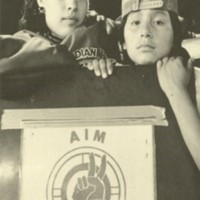
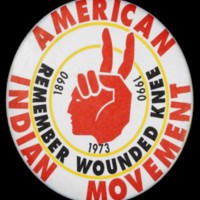

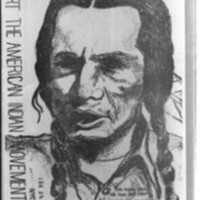
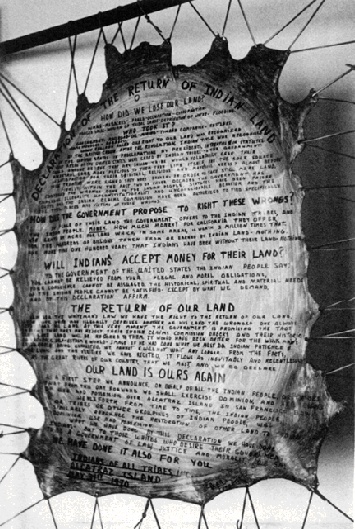
The displayed Alcatraz Proclamation stating the reasons for their right to the island
Taken from: http://www.foundsf.org/index.php?title=ALCATRAZ_Proclamation
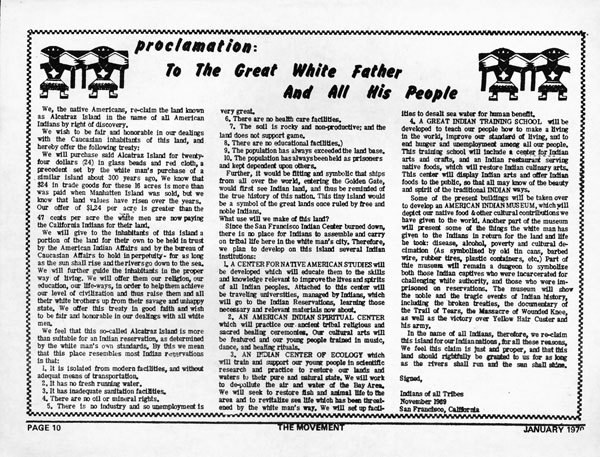
A more clear view of the proclamation
Taken from: https://www.nps.gov/museum/exhibits/alca/exb/Indian/documents/Goga-35158b.html
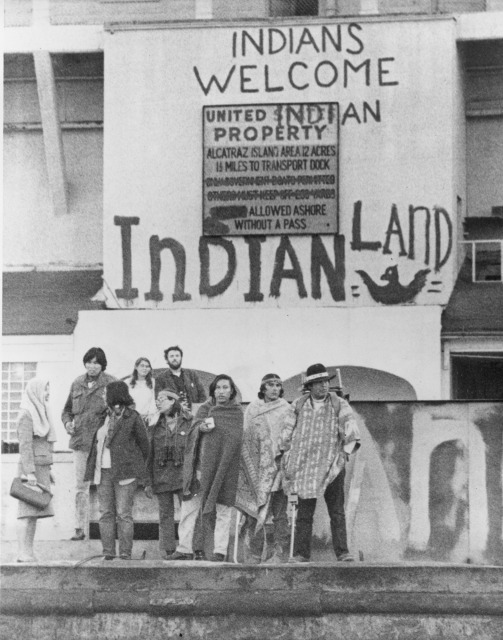
Close up of "United Indian Property" vandalized sign
Taken from: https://www.nlm.nih.gov/nativevoices/assets/timeline/000/000/254/254_w_full.jpg
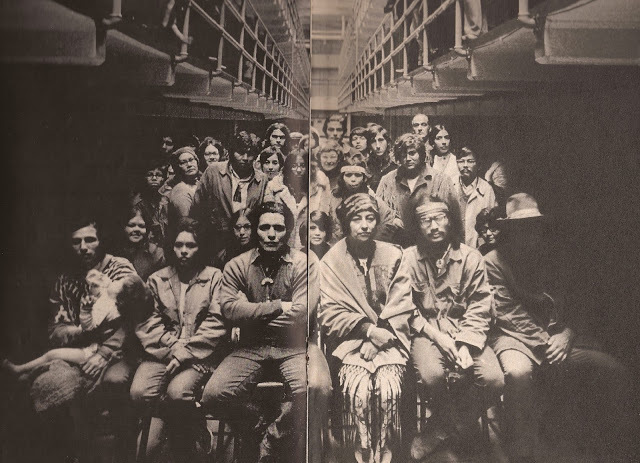
Occupiers in the main cell block of Alcatraz Penitentiary
Taken from: http://alcatrazmemories.blogspot.co.uk/2012/03/friendly-band-of-indians-occupying-main.html
The Catalyst of the American Indian Movement
The dynamic movements of the 1960’s-1970’s gained momentum as several causes came to the forefront following the Civil Rights Movement. Previously believed to avoid protests, American Indians disproved this stereotype at the occupation of Alcatraz starting in November of 1969. It is said that this kickstarted the American Indian Movement. The decision to occupy Alcatraz originates from the government’s House Resolution 108. This policy requires Native Americans to follow the same laws as American citizens. This law rules that reservation lands that were once protected, and limited to Indian tribes, are now open to the public. Concrete justification for their right to Alcatraz was demonstrated in the Sioux treaty of 1868. This treaty stated American Indians would receive land no longer used by the Federal government that was previously theirs.
In March of 1963, Alcatraz Federal Penitentiary was shut down. The first occupation of “The Rock” occurred a year later. Indian students mobilized for the second and third occupations after San Francisco Indian Center caught on fire. The second short occupation took place on November 9th, 1969. This occupation was significant due to media coverage airing the proclamation “To the Great White Father and All His People,” which emphasized the island’s significance to them. The third, final, and longest occupation started on November 20th, 1969. Nineteen months of resistance was organized by Indians of All Tribes. Indians who were reliant on the government for employment and living assistance following their forced removal and relocation found themselves with no means to support themselves. The government failed to implement a program that helped Indians adjust. Instead, Indians were displaced and had to rely on each other for aid. This new sense of community among Indians in a unfamiliar place began the formation of a strongly connected faction that would later be ready to challenge discriminatory practices.
The four hour occupation that took place in March of 1964 was a protest led by five Indians claiming the land and voicing their dissatisfaction with how Indians in the surrounding urban areas were treated. By November 20th of 1969, numerous tribes were ready for a full occupation of the island. The boats transporting 92 Indians successfully avoided the National Guard, and they quickly established themselves on the island. Requests were made for federal funding, but the government refused and decided to not intervene- this would later lead to the demise of the occupation. Despite lack of government aid or acknowledgement, Indians persevered for nineteen months. They vandalized the existing government signage to designate it as Indian property. The plan was to establish a cultural center in contrast with San Francisco's plan to make it a commercial hotspot. Negotiation rather than forced removal was proposed, but the Indian community was unaffected and did not plan to leave. Supplies came in on boats from activists and Indians still living in the Bay area. Facilities were formed rapidly. Housing was available and job formation was a staple of the island to ensure the incoming residents could adapt and function as they normally would. Educational services were provided as well. More Indians relocated to the island due to its success and support even from celebrities. After the daughter of the unofficial leader, Richard Oakes, died, the island transitioned to harsh leadership under Stella Leach. The island was torn into those in support of Leach and those who didn’t like how the island was now being run. Bay Area Native American Council (BANAC) included Bay area Indians and occupiers. The government made a failed attempt to negotiate only with this organization rather than everyone involved in the occupation. All negotiations were refused.
To terminate their means of getting water, the government hauled away the barge providing their only source. When flames broke out, and with no water to put them out, the island’s buildings burnt down. Leaders like Leach left, students came and went, and violence was unavoidable with the remaining residents on the island. When the government’s back up plan was revealed via a reporter, a mere thirty Indians remained. Support was no longer coming in, and most Indians were ready to advocate for their cause in another way. The government sent federal agents to lead removal in 1971, and no resistance occurred. Although the significance of the Alcatraz occupation dwindled drastically near the end, the American Indian Movement became prevalent across the nation. The occupation banded together tribes of students, families, and Bay area citizens to bring attention to an issue that needed national attention, which it earned with great success.
Gallery

Alcatraz Proclamation given by Richard Oakes